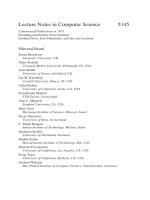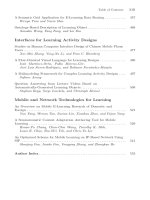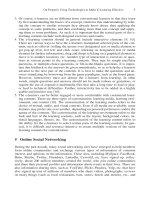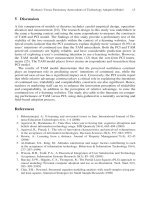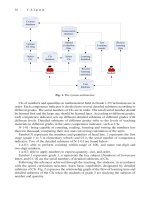Lecture Notes in Computer Science- P35 ppt
Bạn đang xem bản rút gọn của tài liệu. Xem và tải ngay bản đầy đủ của tài liệu tại đây (451.15 KB, 5 trang )
Computer-Aided Generation of Item Banks Based on Ontology and Bloom's Taxonomy 159
Table 1. Number of Items with Bloom's Taxonomy Produced by Teachers Manually
Cognitive Process Dimension
Knowledge
Dimensions
Remember Understand Apply Analyze Evaluate Total
Factual 192 (49.7%) 25 (6.5%) 56 (14.5%) 3 (0.8%) 276 (71.5%)
Conceptual 59 (15.3%) 27 (7.0%) 12 (3.1%) 0 (0%) 98 (25.4%)
Procedural 9 ( 2.3%) 0 (0%) 3 (0.8%) 0 (0%) 12 ( 3.1%)
Total 260 (67.3%) 52 (13.5%) 0 (0%) 73 (18.4%) 3 (0.8%) 386 (100%)
2.2 Course Material Knowledge Ontology
Since the meta-cognitive knowledge of Bloom's Taxonomy is not included in the
regular teaching material or test [5,16], it was not considered in this study. To store
knowledge content of course materials, and to consider the dimensions of Bloom's
factual, conceptual, and procedural knowledge, this study developed a knowledge
ontology, as shown in Fig. 1. This knowledge ontology was developed by content
analysis of specific chapters from the above textbook, and includes the concepts of
WordNet, revised Bloom's Taxonomy, Dublin Core, Semantic Header, and so on.
Chapter &
Section
Knowledge
Topic
Domain
To
pic
Material Knowledge Ontology
Chapter
Section
Common
Feature
Difference
Formula
Rank
Comparison
Condition
Instance
Time
Procedure
Multimedia
Attachment
Figure/
Table
Image/Video/
Audio
Sequence
Cause/
Effect
Theory/
Model
Explanation
Semantic
Relation
Hyponymy
Hypernymy
Challenge
Weakness
Advantage
MeronymyHolonymy AntonymySynonymyNear Synonymy
General
Characteristics
Definition
Benefit
Author Publisher
Knowledge
Content
Other
Property
Description
Date Format Keyword Language
Relation
With
Fig. 1. Course Material Knowledge Ontology
Figure 1 uses the “Knowledge Content” to store the real course material content,
and comprises 12 subclasses of knowledge, which are used to store knowledge con-
cepts such as “What”, “Why”, “When” and “How”. For example, sequence relation
knowledge includes procedure (the procedural step, used to express the concept of
“How”), time (the time sequence), rank (specific attribute rank). Hypernymy knowl-
edge records a relation similar to generalization, is-a relation, is-a-kind-of. Meronymy
knowledge records a relation similar to component-of.
The proposed course material knowledge ontology covers the knowledge dimen-
sion of Taxonomy of Bloom, as detailed below.
160 M H. Ying
and H L. Yang
z Factual Knowledge:
¾ Knowledge of terminology including technical vocabulary and musical
symbols. In Fig. 1, such type of knowledge is stored through “Descrip-
tion” and “Multimedia Attachment”.
¾ Knowledge of specific details and elements: major natural resources and
reliable sources of information. In Fig. 1, such type of knowledge is
stored through “Description”, “Property”, “Instance”, “Holonymy”,
“Meronymy”, “Near Synonymy”, “Synonymy”, and “Antonymy”.
z Conceptual Knowledge:
¾ Knowledge of classifications and categories: geological time periods. In
Fig. 1, it would be stored through “Hypernymy”, “Hyponymy”, “Time”,
and “Rank”.
¾ Knowledge of principles and generalizations: In Fig. 1, it would be stored
through “Hypernymy”, “Hyponymy”, “Comparison”, and “Multimedia
Attachment”.
¾ Knowledge of theories, models and structures: In Fig. 1, it would be
stored through “Theory/Model”, “Cause/Effect”, and “Multimedia At-
tachment”.
z Procedural Knowledge:
¾ Knowledge of subject-specific skills and algorithms: In Fig. 1, it would be
stored through “Formula”.
¾ Knowledge of subject-specific techniques and methods: In Fig. 1, it
would be stored through “Procedure”.
¾ Knowledge of criteria for determining when to use appropriate proce-
dures: In Fig. 1, it will be stored through “Condition”.
2.3 Test Item Structure Ontology
The test item structure ontology includes an intelligent online test scoring mecha-
nism [28], which includes various parameters for dealing with fill-in-the-blank
tests. In Fig. 2, the item structure ontology includes four question types: true-false,
multiple-choice, multiple-response, and fill-in-the-blank. The ontology also in-
cludes original and variable item types. The question steam of original items can be
generated based on primitive online material knowledge, in which case the structure
of the question steam does not require any special changes. The original item is
primarily used to assess the “remember” level of the cognition process. The struc-
ture of the question steam of variable items differs from that for online material
knowledge. Furthermore, the variable item is used to assess the “understand, apply,
analyze, and evaluate” levels of the cognition process. The variable items are di-
vided into structure variable items and operands variable items. The structure vari-
able items are generated by changing the structure, words of material knowledge.
Moreover, the operands variable items are generated by calculation or formula in-
ference module.
Computer-Aided Generation of Item Banks Based on Ontology and Bloom's Taxonomy 161
Chapter
Section
Question
Type
Fill-in-Blank
True-False
Question Stem
Answer
Answer options
Multiple Choice
Set
Comparison
Paramete
r
Multiple Blank
Single Blank
Missing
Character
Paramete
r
Semantics
Scoring
Paramete
r
Homonym
Analysis
Parameter
Concept
Number
Item
Number
Item
Score
Material
Mapping
Feedback
Knowledge
Dimension
Cognitive
Dimension
Item Structure Ontology
Variable Item
Structure Variable Item
Operands Variable Item
Original Item
Multiple Response
Fig. 2. Test Item Structure Ontology
2.4 CAGIS System Architecture
This study designed a computer-aided generation of items prototype system (CAGIS)
in a three-tier Client/Server architecture. The back-end database server was Microsoft
SQL Server 2000, which was used to implement trigger procedures and store the
items, material, student data, scores, and so on. The web server was the Internet In-
formation Server in Windows 2003. ASP language was adopted in the server-side.
The architecture of the CAGIS E-learning system is shown in Fig. 3. The components
are briefly described below.
This structure includes two user interfaces, five subsystems and 18 relevant data-
bases. They are briefly described below. The Word Segment Process Subsystem seg-
ments the Chinese words in the primitive knowledge article, and stores the segmented
results in the Expertise WS Knowledge Base. The Computer-Aided Generation of Ma-
terial & Presentation Subsystem retrieves the segmented material knowledge from Ex-
pertise WS Knowledge and uses it to generate an online material knowledge, and stores
it in the Material Knowledge Base. It can also dynamically generate teaching material
pages that students can learn online. The Computer-Aided Generation of Item Subsys-
tem, the focus of this study, can analyze the content of the Material Knowledge Base,
generates various item types by referring to Item Structure Ontology and rules of item
generation, and stores these items and standard answers in the Item Bank. The Online
Test & Intelligent Scoring Subsystem manages testing and scoring. The Assisting
Learning Tool Subsystem provides tools to assist learner leaning.
162 M H. Ying
and H L. Yang
Users (Student)
Online Test & Intelligent Scoring Subsystem
Test
Results
Course
Resource
Homewor
k
Database
Appeal
Recor
d
Learning
Portfolio
Forum &
Discussion
Assisting Learning Tool Subsystem
Scoring
Paramete
r
Original
Material
General WS
Knowled
g
e
Field Topic
Words
Formula
Schema
Knowledge
Pattern
Material
Knowled
g
Computer-Aided Generation of Item Subsystem
Item
Ontolo
gy
Item Pattern
Database
Item Ban
k
Semantic
Relation
User Interface (to learn, test, query portfolio, discuss, etc.)
Word Seg. Process Subsystem
Expertise WS
Knowledge
Computer-Aided Generation of Material & Presentation Subsystem
Material
Ontolo
gy
Teacher/Administrator Interface (to manage item bank, material, etc.)
Teacher/Administrator
Fig. 3. CAGIS E-learning System Architecture
2.5 Computer-Aided Generation of Item Subsystem
Figure 4 shows he architecture of the Computer-Aided Item Generation Subsystem.
From a 3*5 table of Bloom’s taxonomy (“factual, conceptual, procedural” knowledge,
and cognitive levels of “remember, understand, apply, analyze, evaluate”), teachers
could assign numbers of four types of automatically generated test items: true-false,
multiple-choice, multiple-response, and fill-in-the-blank. The components are pre-
sented below:
z Formula Schema Database: Storing the knowledge rule of mathematical formu-
lae, logic operations, or equations.
z Knowledge Pattern Database: Storing the regular rules of Chinese grammar
structure, semantic relations between words, and notation of word segments cor-
responding to Chinese sentences in general textbooks.
z Material Knowledge Database: Storing the knowledge content of the material.
The knowledge was stored based on Material Knowledge Ontology. Relevant
Computer-Aided Generation of Item Banks Based on Ontology and Bloom's Taxonomy 163
knowledge can be linked by semantic relations. It is a knowledge source for gener-
ating online material in the Computer-Aided Generation of Material Subsystem
and generating items for the Computer-Aided Generation of Item Subsystem.
z Module of Item Pattern: It provides a function for managing and maintaining
the rules (characteristics) of item patterns, semantic relations, and question types
for item generation.
z Item Pattern Database: Storing the rules (characteristics) of item patterns, se-
mantic relation, and question type.
z Module of Item Ontology: This module provides a function for managing the
item structure ontology.
z Item Ontology Database: Storing the item structure ontology.
z Computer-Aided Generation of Item Module: It executes the tasks involved in
item generation. The module takes the knowledge content newly entered from the
Material Knowledge Base, seeks other correlated existing knowledge concepts
and checks the rules governing the item pattern. If the check is passed, the com-
puter automatically generates the item and stores it in the item bank.
z Item Bank: Storing the items generated by Computer-Aided Generation of the
Item Module. Alternatively, items created manually by teachers can also be
stored if necessary.
z Semantic Relation Database: Storing the semantic relationships among words,
including semantic words, correlation types (Near Synonymy, Synonymy, an-
tonymy, etc.), and correlation ratios.
Computer-Aided Generation of Material
Teacher/Administrator
Computer-Aided Generation of Item Module
Item Ban
k
S
emantic
Relation
Module
of Item
Ontolo
gy
Module of
Item
Pattern
Item
Ontolo
gy
Item
Pattern
Teacher Interface
Material
Knowled
g
e
Knowledge
Pattern
Formula
Schema
Fig. 4. Architecture of Computer-Aided Generation of Item Subsystem
2.6 Structure Rules of Knowledge Type and Item Generation Method
The Computer-Aided Generation of Item subsystem generates ten types of knowl-
edge, Description, Property, Theory/Model, Cause/Effect, Sequence, Semantic Rela-
tion, Comparison, Formula, and Instance, and Others. The Formula Knowledge was
created based on the formula schema set by teachers, the other nine knowledge types
have their structure rules. These rules identify the knowledge type of original article
contents, and store material knowledge that has been segmented to corresponding
relation tables of the database. For illustration, some item generation methods are
briefly described below.

